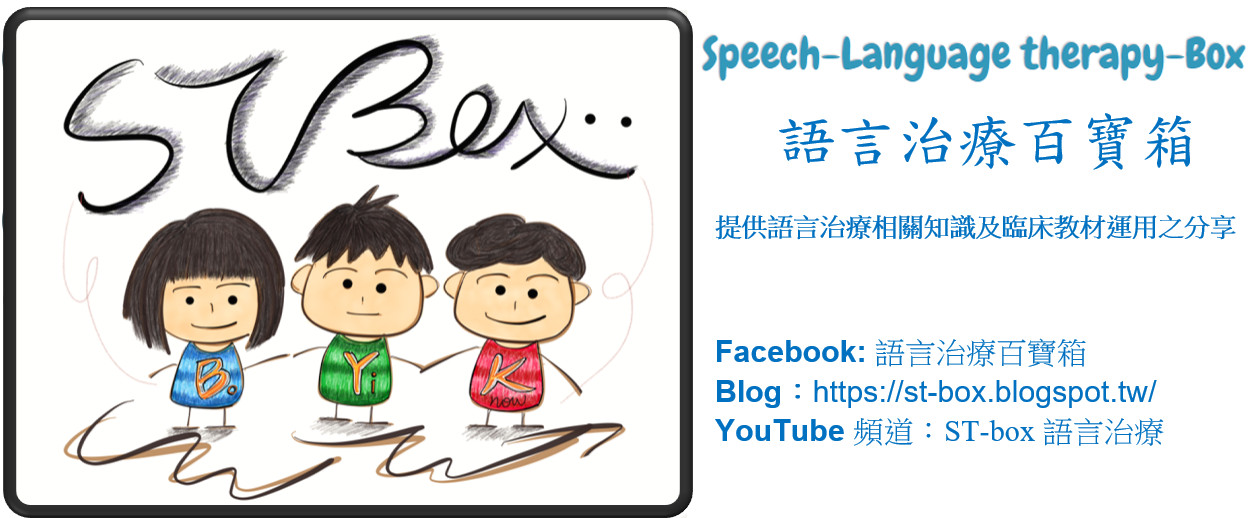語暢問題的治療是具個別化且基於評估其言語流暢性,語言因素,情緒及態度要素與對生活的影響而決定.多數語暢問題的兒童都會面臨其可觀察到的不流暢行為和對生活的影響,如:負向的互動回饋,對於說話情境轉換的困難,都可能會影響到兒童的生活品質.
Treatment Approaches: Preschool Children Who Stutter
(學齡前口吃兒童之治療)
⊙ treatment
approach (治療的取向:針對"家長及孩子"的策略)
-parent-focused strategies
-child-focused strategies
⊙ goals of treatment (治療的目標)
-eliminate, greatly reduce
stuttering (減少口吃行為)
-help children manage their
stuttering (幫助孩子控制口吃)
-not develop negative emotional
reactions related to their stuttering (不讓孩子對口吃發展負面情緒)
語言治療師與家長一起察覺孩子的行為,學齡前口吃兒童的治療將家長納入治療的過程是重要的,因為家長對口吃的認識及針對孩子的口語及非口語的支持都有助於減少孩子對口吃發展負面態度.
Indirect
間接治療
counseling families about how to make
changes in their own speech and how to make changes in
their child's environment.
-reducing communication rate
-using indirect prompts rather than direct
questions
-recasting/rephrasing to model fluent speech
重點在與家長諮商: 家長可以如何改變自己的說話方式及孩子的說話環境.包含大人放慢
自己溝通速度. 使用間接地暗示而不是用直接的問題回應.重新示範如何流暢的說話
Direct
直接治療
changing the child's speech in order to
facilitate fluency
-speech modification and
stuttering modification strategies :
-reduce disfluency rate, physical tension, and
secondary behaviors
-children's communication
attitudes
直接改變孩子的言語以誘發其流暢性:言語的修正及口吃修正策略,
包含:減少不流暢的比率,身體張力及次要行為,孩子的溝通態度.
Operant
操作治療
The principles of operant conditioning and
uses a response contingency to reinforce the child
for fluent speech and redirect disfluent speech.
基於操作制約的原理,增強孩子流暢的言語和重新建立流暢的言語
口吃的治療不僅僅是處理表層的不流暢問題,也應考量口吃者個人的溝通經驗,包含日常生活中個人,環境情境及活動的情形.這才是最重要的.
Treatment
Approaches: School-Age Children and Adolescents Who Stutter
(學齡兒童及青少年口吃者之治療)
⊙ goals of treatment
-increasing fluency (增加流暢性)
-increasing acceptance of stuttering and of
being a person who stutters
(接受口吃及身為口吃者)
-reducing secondary behaviors, minimizing
avoidance, improving communication skills
(減少次要行為.逃避以改善溝通技巧)
-increasing self-confidence, managing
bullying effectively, and ultimately, minimizing the
adverse impact of stuttering on the child's
life
(提升自我信心.處理校園霸凌.以減少口吃對個案生活的影響)
For example: desensitization exercises
and by educating
the child's peers about.
(減敏感練習及教育同儕對於口吃的了解)
依據ICF: Strategies For Reducing Impairment In Body Function
⊙Speech
Modification Strategies (fluency shaping)
the aim to make changes to the timing and tension of speech production or that alter the
timing of pauses between syllables and words. 原理在於改變言語產生的時間點及張力或是轉變音節和字詞間的暫停之時間
- rate control速度控制
- continuous phonation 連續發聲
- prolonged syllables, 拉長音節
- easy onset,輕鬆起始
- light articulatory contact. 輕輕地構音
有些兒童對於口吃會感到不好意思.或是對於策略有負面的感覺.通常是因為他們覺得聲音不自然,這也是臨床上須留意的地方.
⊙Stuttering
Modification Strategies (Reducing Physical Tension/Struggle)
Aim to reduce
associated physical tension and struggle by helping children to identify core
stuttering behaviors, recognize physical concomitant behaviors, locate the
point of physical tension and struggle during moments of disfluency, and
ultimately reduce that physical tension.
協助孩子去辨識口吃行為, 生理伴隨行為,當口吃發生時找出生體的張力所在以減少生理性張力.幫助孩子學習言語機轉及如何控制流暢及不流暢言語讓孩子能修正、增加自我覺察及自我監控技巧, 以幫助孩子減少不流暢的干擾. 也讓孩子能更進一步處理減少張力及干擾溝通的情形.其治療策略包含:
-preparatory set
-pull-out
-cancellation
策略的選擇依據個案什麼時候"抓到"不流暢, 如:發生不流暢的當下或是在發生不流暢前
◎所有策略的運用需考量在不同的階層性的說話情境, 包含語言層面及環境中壓力的層級
⊙Increasing Speech Efficiency (Reducing Word
Avoidance)
Some
children develop speech habits to escape or avoid moments of overt stuttering,
such as changing words or using interjections (e.g., "um,"
"uh") and may become so skilled at hiding stuttering that their
speech appears to be fluent.
有些兒童會發展自己的言語習慣: 逃避口吃 如改變字詞或是只用插入音.以隱藏它們的口吃情形讓言語呈現流暢.這逃避的代價可能是很大的.因為會影響他們真正想說的內容.
這些兒童可能從治療策略中獲益.改善言語效度和增加自發性的對話.讓他們能說出想說的事.可能會出現很多表層的口吃.然而兒童學習到在說話時能更有自信.對於自己溝通的能力有正向的態度.且更有能力去接受及處理口吃的發生.
⊙Strategies
For Reducing Negative Reactions減少負向行為:
1.Desensitization
減敏感
Desensitization
strategies help speakers systematically desensitize themselves to their fears
about speaking and stuttering by facing those fears in structured, supportive
environments. One example of a desensitization activity is the use of voluntary
stuttering (“pseudostuttering”) in different situations where the client might
fear the occurrence of real moments of stuttering .
有系統性的減低口吃者對於說話和口吃的恐懼.. 如:假裝口吃行為,可在不同的情境中練習
2.Cognitive Restructuring 認知重建
Cognitive
restructuring is designed to help speakers change the way they think about
themselves and their speaking situations
幫助口吃者改變對自己的看法及它們說話的情境.
3.Self-Disclosure 自我披露
Self-disclosure
involves communicating to others information that reveals one's identity as a
person who stutters.
向他人溝通說明口吃者相關的訊息,如:談論什麼是口吃,口吃的治療,口吃的症狀,如何回應口吃者…等. 如果是學齡兒童可以藉由老師或語言治療師於班上說明口吃相關的訊息.
4. Support
支持
Support (both
giving and receiving) can be valuable for improving attitudes, boosting
self-confidence, and reducing feelings of isolation
支持可以改變態度,建立自我信心及減少孤立感. 在治療取向中可以提供在安全情境學習策略然後逐漸類化該技巧.可於團體治療建立支持活動.或是參與自助團體(如:FRIENDS-The
National Association of Young People Who Stutter, the National Stuttering
Association (NSA)),提供口吃者及家屬相關的支持團隊也是臨床重要的一環.
依據ICF, Strategies
For Reducing Activity Limitations And Participation Restrictions:
⊙Generalization
Activities
協助孩子將技巧運用在不同的情境中,如:同儕進入治療室中,計畫在教室中使用的策略,打電話或是購物的情境…等.需考量個別差異,以及所提供情境中語言技巧及環境壓力等層面.
Need to consider the individual's profile prior
to developing generalization activities.
assignments adhere to a hierarchy of
linguistic skills and environmental stressors.
⊙Accommodations
At School and In the Community
-using audio/video recording,
-increasing the time provided for an oral
reading or presentation
-providing
an alternative assignment to oral reading
-altering
the size of the group or audience.


沒有留言:
張貼留言